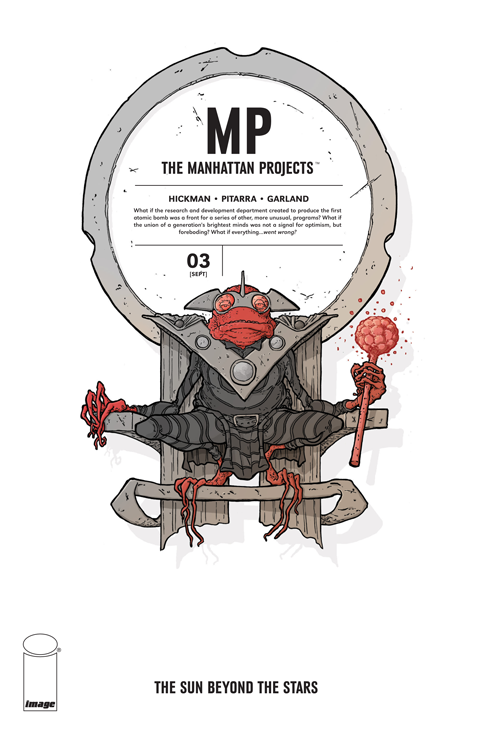Three issues deep into "The Sun Beyond the Stars," and this incarnation of "The Manhattan Projects" isn't wowing me like its predecessor. Yuri and Laika's adventure through space is wacky and entertaining, with humor aplenty in Jonathan Hickman's script and weird, wild creativity in Nick Pitarra and Michael Garland's art. However, the plot doesn't feel strong enough to carry a series on its own. With no real stakes and a newly unmotivated main character, this issue just didn't draw me in. While I'm not yet ready to give up the joy of exploring Pitarra's zany, grotesque world every month, "The Sun Beyond the Stars" can't quite get its hooks in me.
Admittedly, part of this may be an adjustment. I really enjoyed the intertwining stories and large cast of the original, so the straightforwardness of Yuri's journey feels emptier and slower. In the first issue, his motivation was just to find his dog; now reunited with Laika, his motive is merely survival. Survival is no small motivation and it can make for an invigorating story, but "The Sun Beyond the Stars" can't decide on its tone. The upside-down morality of Judge Ryleth, the vengeful scheming of Primor and the dictatorship of the Great Sionox are just as wacky as they are threatening. As a result, it's difficult to feel any real sense of danger for Yuri and Laika, but Hickman also doesn't go full absurdist. The result is fun, but not hilarious, like a too-mellow "Hitchiker's Guide."
With another artist on the book, this might be enough for me to drop it, but Pitarra's world building is such a pleasure. Creative and cohesive, his zany, disturbing vision of space is unlike anything else on the shelves. When critics talk about lived-in science fiction, they often mean gritty realism, but Pitarra makes this world "lived in" by focusing on the often nasty reality of having a physical body. He covers his aliens with grotesque texturing, all pocked and bubbled, and each new creature is just ugly enough to give the whole book an undercurrent of body horror. The reader sees Primor's gums and tonsils when he speaks; Laika's hands are oversized, and Rys' two faces are forever grimacing as if in stress or pain.
Colorist Michael Garland injects the issue with some funkiness. His bright, flat palette complements Pitarra's texturing, and it can move from semi-clinical harshness, as when Yuri repairs Una, to a richer, cartoonier color on the Science Council Homeworld. As a result, the book feels full and varied in its strangeness -- an essential characteristic for a universe-hopping adventure.
While solid, "The Manhattan Projects: The Sun Beyond the Stars" #3 doesn't do the pick-up work this series needs to match the original "Manhattan Projects." While every series is different and there's no reason this needs to be the same as what came before it, I'd love to see "The Sun Beyond the Stars" get to a place where it can wow me with more than the artwork.

